AI tools are reshaping how we work in 2025. From automating workflows to designing visuals, these apps save time and boost efficiency. Here's a quick look at the standout tools making waves this year:
- AI Apps: A directory for discovering over 1,000 AI tools by category and budget.
- Otter.ai: Converts meetings into real-time transcriptions and summaries.
- Notion AI: Enhances writing and knowledge management within Notion.
- Runway ML: Generates videos from text prompts and offers advanced editing tools.
- Motion: Automatically schedules tasks and optimizes calendars.
- Zapier: Automates workflows by connecting thousands of apps.
- Perplexity AI: Delivers source-backed answers for research questions.
- Canva AI: Simplifies graphic design with AI-powered tools.
- Rev AI: Transcribes audio and video while identifying key insights.
- DALL-E 3: Creates custom images from text descriptions.
- Gamma: Builds professional presentations from simple outlines.
Each tool addresses specific needs, from content creation to task management. Whether you're a freelancer, business owner, or part of a large team, there's an AI app that fits your workflow.
Quick Comparison
| Tool | Best For | Pricing (USD) | Key Features |
|---|---|---|---|
| AI Apps | AI tool discovery | Free (freemium) | Filters by category and budget |
| Otter.ai | Meeting summaries | Free to $30/month | Real-time transcriptions |
| Notion AI | Writing assistance | Included in Notion plans | AI-powered content generation |
| Runway ML | Video generation | Free to $76/month | Text-to-video, object removal |
| Motion | Scheduling & time management | $34/month | AI task scheduling |
| Zapier | Workflow automation | Free to $415/month | Multi-step automation |
| Perplexity AI | Research & Q&A | Free | Conversational answers with sources |
| Canva AI | Graphic design | Free to $15/month | AI design tools |
| Rev AI | Transcription | Pay-as-you-go | Speaker identification, custom vocab |
| DALL-E 3 | Image generation | $20/month+ | Text-to-image generation |
| Gamma | Presentation creation | Free to $20/month | AI-generated slides |
These tools simplify complex tasks, enabling you to focus on what matters most. Dive into the article for detailed reviews of each app.
7 Best AI Tools You NEED to Try in 2025 (Free & Powerful!) 💡
1. AI Apps - Best for AI Tool Discovery

AI Apps is a platform designed to simplify the discovery of AI tools, offering a curated selection of over 1,000 applications across various categories. By combining usage metrics with expert editorial insights, it provides users with a balanced perspective - grounding decisions in real-world data while highlighting tools that stand out.
Core Features
AI Apps streamlines the search process with filtering and search tools that let users sort by category, sub-category, and pricing model. Tools are grouped into categories like AI Art Generators, AI Text Generators, AI Video Tools, and productivity solutions, making it easy to find the right fit.
The platform ensures quality by implementing a multi-step verification process and regularly updating its listings. Featured and newly launched tools get prominent placement, while users can explore both free and paid options, complete with detailed descriptions of each tool's features and use cases.
To keep the directory fresh, AI Apps includes a developer submission system, allowing creators to update or add their tools. This approach makes the platform valuable for a wide range of users, from small business owners to enterprise teams.
Use Cases
- Small business owners benefit from AI Apps by building AI stacks without spending hours on research. They can filter tools by budget and shortlist options using download and review metrics.
- Content creators and marketers use the platform to quickly find tools for tasks like video creation, image generation, and text automation. The category-based layout helps them integrate new tools into their existing workflows.
- Enterprise teams rely on its filtering features to identify tools that align with their current systems. They focus on applications with proven market success, backed by metrics like user activity and revenue.
Pricing in USD
AI Apps follows a freemium model, making its directory and search features free to access. This ensures affordability for individuals and small businesses exploring AI tools.
For tool developers, basic listings are free, but featured listings require payment. These paid spots boost visibility through homepage placement and priority in category searches. This pricing structure mirrors common practices among other AI platforms.
Limitations
While AI Apps is a powerful resource, it has a few limitations:
- The platform depends on developer submissions, so some newer or niche tools might not appear immediately in the directory.
- Since there’s limited hands-on testing of listed tools, users still need to evaluate performance independently. While the platform provides metrics and descriptions, detailed comparisons require additional research.
- The fast-paced nature of AI development means tool details - like features, pricing, and availability - can quickly become outdated. Users are encouraged to verify information directly with tool providers before making decisions.
These considerations are important when weighing AI Apps against other platforms discussed later.
2. Otter.ai - Best for Meeting Summaries
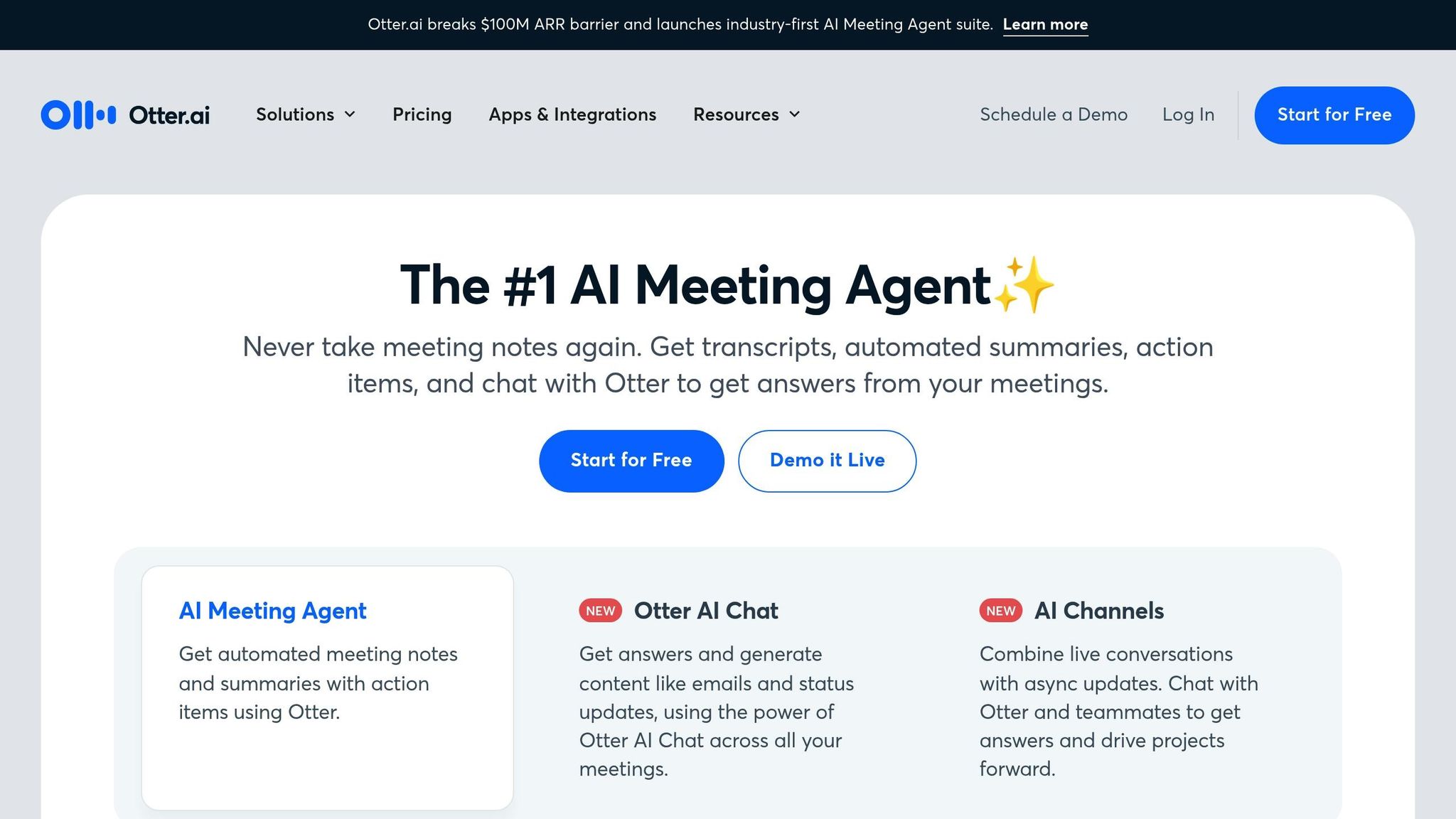
Otter.ai is designed to turn meeting recordings into real-time transcriptions and summaries, automatically capturing key points like decisions and action items. It integrates seamlessly with Zoom, Microsoft Teams, and Google Meet, joining virtual meetings to record and organize discussions. This focus on meeting transcription aligns with the growing demand for AI tools that streamline productivity.
Core Features
Otter.ai's AI meeting assistant provides real-time transcription in multiple languages, complete with automatic speaker identification and tagging. It uses AI meeting templates to structure discussions and allows users to query transcripts directly - for instance, asking, "What were the main action items?"
The platform supports up to three simultaneous recordings on higher-tier plans and offers features like adjustable playback speeds (ranging from 0.5× to 3× with silence skipping), real-time annotation, and bulk exports in formats like MP3, TXT, PDF, DOCX, and SRT.
Use Cases
- Sales Teams: Enterprise users can pull insights from meetings and sync notes directly with tools like Salesforce and HubSpot.
- Education: Professors and students with .edu email addresses can access a 20% discount on Pro plans, making it easier to transcribe lectures or study group discussions.
- Remote Teams: Shared workspaces allow teams to tag speakers, assign tasks, and collaborate effectively.
Pricing in USD
| Plan | Monthly Price | Annual Price | Monthly Minutes | Key Features |
|---|---|---|---|---|
| Basic | Free | Free | 300 minutes | Real-time transcription, 20 AI chat queries, 5 workspace members |
| Pro | $16.99/user | $8.33/user | 1,200 minutes | Advanced templates, 50 AI chat queries, enhanced search |
| Business | $30/user | $20/user | 6,000 minutes | Admin features, 200 AI chat queries, 25 workspace members |
| Enterprise | Custom pricing | Custom pricing | 6,000 minutes | SSO, CRM integrations, 500 AI chat queries |
For the Enterprise plan, a minimum of 100 users is required, and pricing is customized. Data from Vendr indicates that Enterprise deals average $6,323 annually, with some agreements reaching as high as $35,000 per year.
Limitations
While Otter.ai is powerful, it does have some drawbacks. Transcription accuracy can drop in poor audio conditions, particularly with heavy accents, technical terminology, or background noise. Speaker identification in group settings may need manual adjustments, and some users have reported that the interface feels disjointed at times. Additionally, managing access often requires individual recording owners to grant permissions, which can complicate team-wide sharing.
3. Notion AI - Best for Workspace Writing and Knowledge Queries
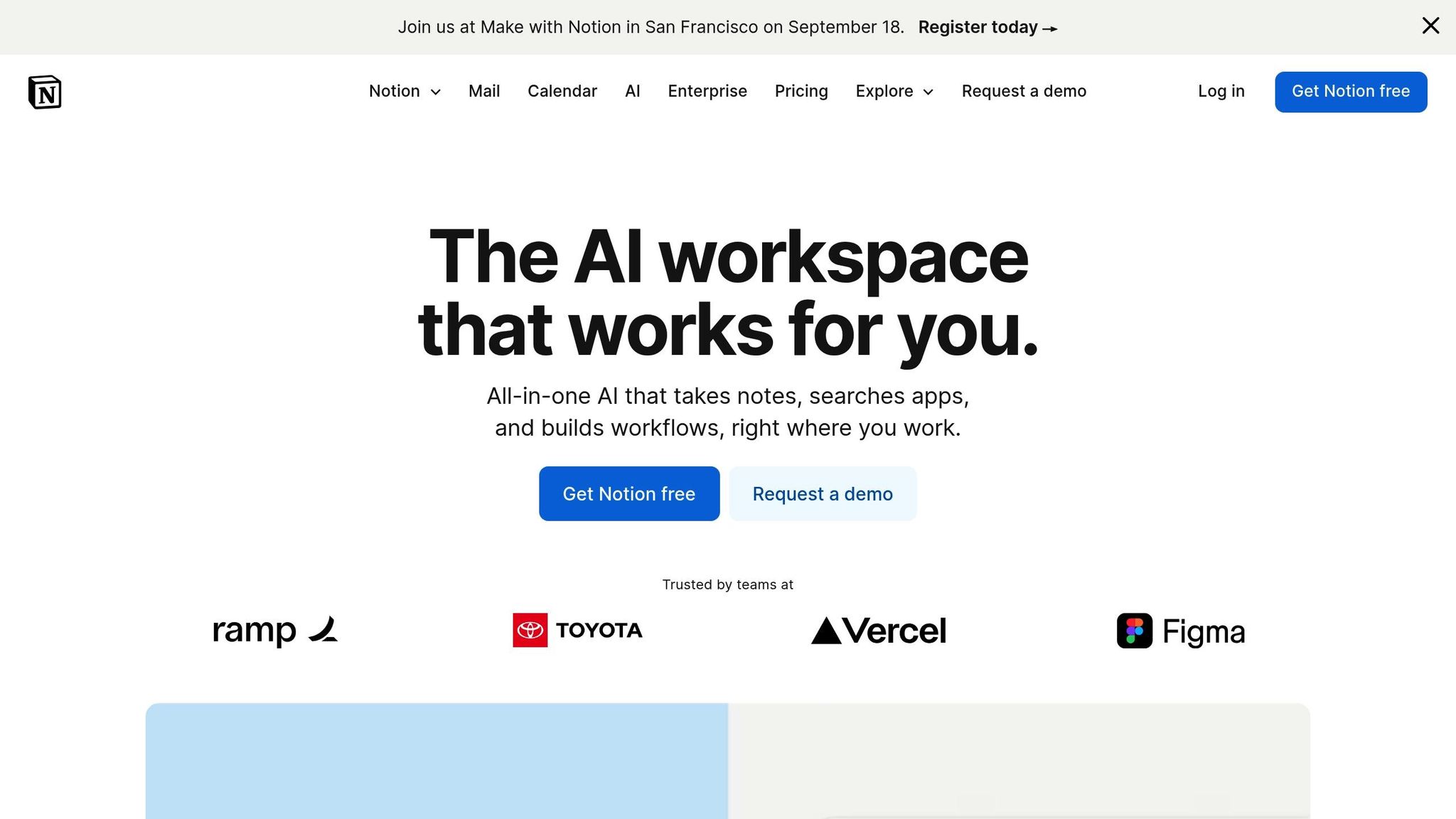
Notion AI brings an intelligent edge to Notion, transforming it into a powerful writing assistant and knowledge management tool. It helps teams create content, analyze data, and retrieve workspace information - all through natural language. This seamless integration allows users to tap into AI capabilities without ever leaving their primary productivity platform.
Core Features
Notion AI acts as a versatile writing assistant, capable of generating a wide range of content, from blog posts and meeting agendas to project plans and creative drafts. Users can highlight specific text to request improvements, summaries, or translations. By analyzing the surrounding content, it provides suggestions that match the tone and purpose of the document.
A standout feature is its Q&A functionality, which allows users to query their workspace. For instance, asking, "What were the main points from last quarter's marketing meetings?" prompts the AI to search through relevant pages, databases, and documents to deliver a detailed answer.
It also processes structured data, identifying trends and generating reports, while offering tailored template suggestions for different content types, such as product roadmaps, employee handbooks, or research notes. These features make it a versatile tool for professionals across various industries.
Use Cases
Notion AI’s capabilities cater to a wide range of team needs:
- Content Teams: They can draft blog posts, social media updates, and marketing copy while ensuring brand consistency. The AI can reference existing guidelines and past content to maintain a cohesive voice.
- Project Managers: Instead of manually gathering updates from various sources, they can query the AI to generate detailed project summaries that pull data from multiple sections of the workspace.
- Research Teams: Academic researchers and consultants use the AI to analyze notes, create literature reviews, and compile executive summaries from large volumes of documentation.
Limitations
The tool’s performance relies heavily on how well the workspace is organized. Poorly structured databases or incomplete records can lead to less accurate results. It may also face challenges with highly technical or specialized terms that fall outside its training data. Additionally, while it excels at straightforward tasks, it may struggle with complex or nuanced queries that require deeper contextual understanding.
4. Runway ML - Best for AI Video Generation
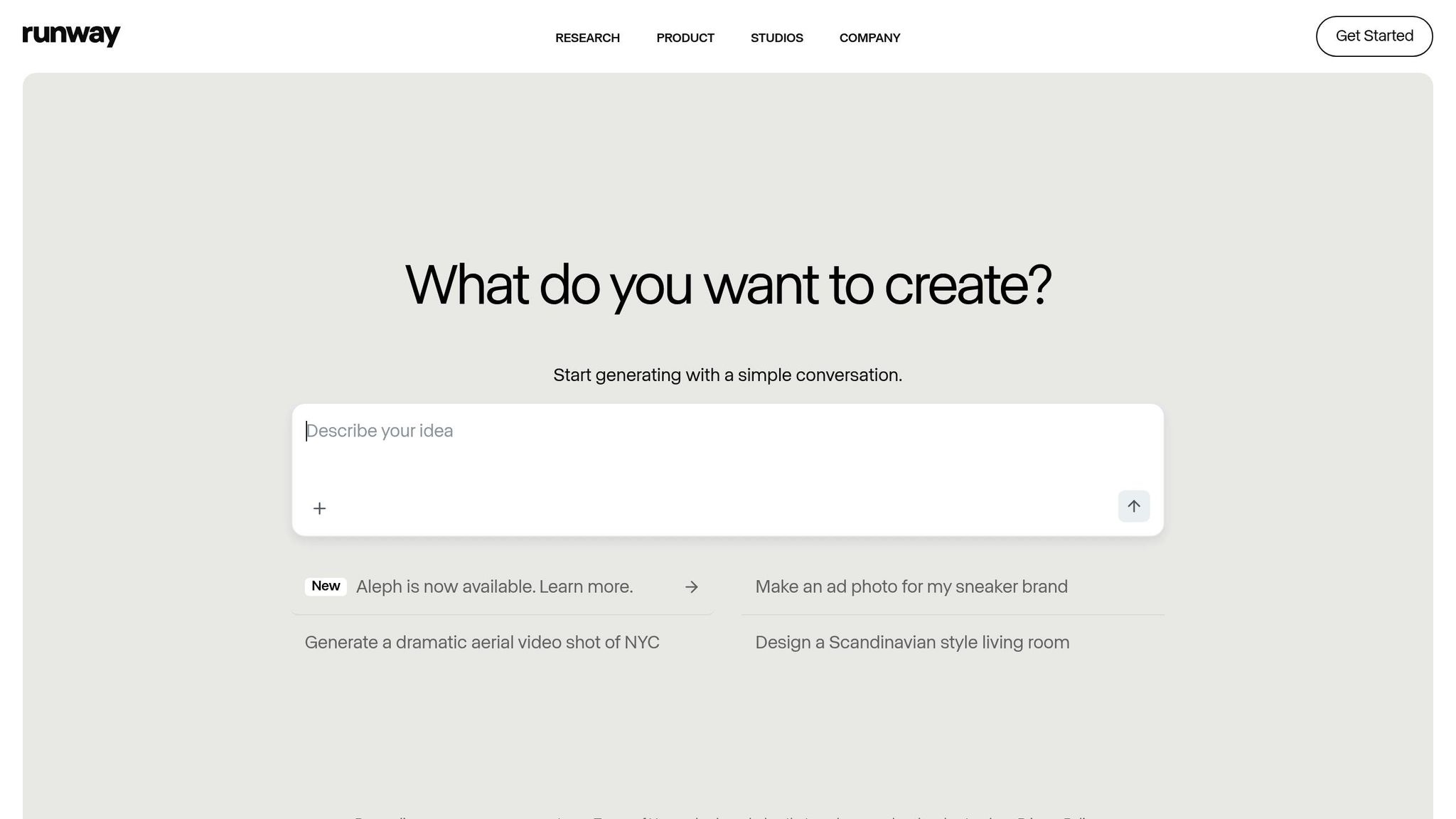
Runway ML is changing the game for video production by harnessing the power of artificial intelligence. With its user-friendly interface and cutting-edge AI models, this tool allows creators to generate, edit, and refine videos with ease. From creating videos based on text prompts to advanced editing features like object removal and style transfer, Runway ML caters to creators of all experience levels.
Core Features
Runway ML's Gen-2 model is a standout feature, enabling users to create short videos from simple text prompts or static images. For instance, you could type something like "a golden retriever running through a sunlit forest", and the platform will generate video footage in no time. The image-to-video capability adds another layer of creativity, letting users transform static images into dynamic video content.
The platform's Magic Tools suite offers over 30 AI-powered editing features. Highlights include Green Screen, which removes backgrounds without needing a physical green screen, and Inpainting, which lets users seamlessly erase unwanted objects from video frames. The Motion Brush tool gives creators precise control over specific movements in the video, such as directing how water flows or clouds move.
Runway ML also supports real-time collaboration, allowing teams to work together on projects with features like version control and commenting. Its API integrations make it easy to incorporate AI-generated content into existing workflows, ensuring smooth compatibility with popular editing software. These tools are designed to save time and simplify the creative process.
Use Cases
Runway ML is a versatile tool with applications across various industries:
- Marketing agencies use it to produce product demos and social media content quickly and efficiently.
- Content creators rely on it for generating B-roll footage, saving money on stock video subscriptions.
- Independent filmmakers utilize it for pre-visualization, creating rough cuts and conceptual videos before full-scale production.
- Educational institutions create instructional videos and visual aids to enhance learning experiences.
- Small businesses produce promotional videos without needing to hire professional production teams.
Its quick turnaround capabilities make it especially valuable for social media managers creating daily content or marketers responding to trending topics.
Pricing in USD
Runway ML uses a credit-based pricing model, offering flexible options to suit different needs:
- Free Plan: Includes 125 credits per month, enough to create 5-10 short videos.
- Standard Plan: Priced at $12.00 per month, providing 625 credits.
- Pro Plan: Costs $28.00 per month and offers 2,250 credits along with priority processing.
- Unlimited Plan: For $76.00 per month, users get unlimited video generation with relaxed mode processing.
- Enterprise Plan: Starting at $500.00 per month, this plan includes custom models, dedicated support, and advanced security features.
Credits are consumed at a rate of about 10 credits per second of video footage, making it easy to plan budgets based on project needs.
Limitations
While Runway ML offers impressive capabilities, it does have some limitations. Video quality can vary depending on the complexity of the prompt. For example, abstract ideas or highly detailed scenes might require multiple attempts to achieve the desired result. Additionally, generated videos are capped at 4 seconds, which can be restrictive for longer projects - though users can combine multiple clips to work around this.
During peak usage times, free-tier users may experience slower processing speeds due to lower priority in the generation queue. Consistency across clips can also be an issue, making it tricky to create cohesive longer videos with recurring characters or environments. Occasionally, generated content might include visual artifacts or unrealistic elements, necessitating manual editing to refine the final product. Understanding these limitations is essential to getting the most out of the platform.
5. Motion - Best for Scheduling and Time Management
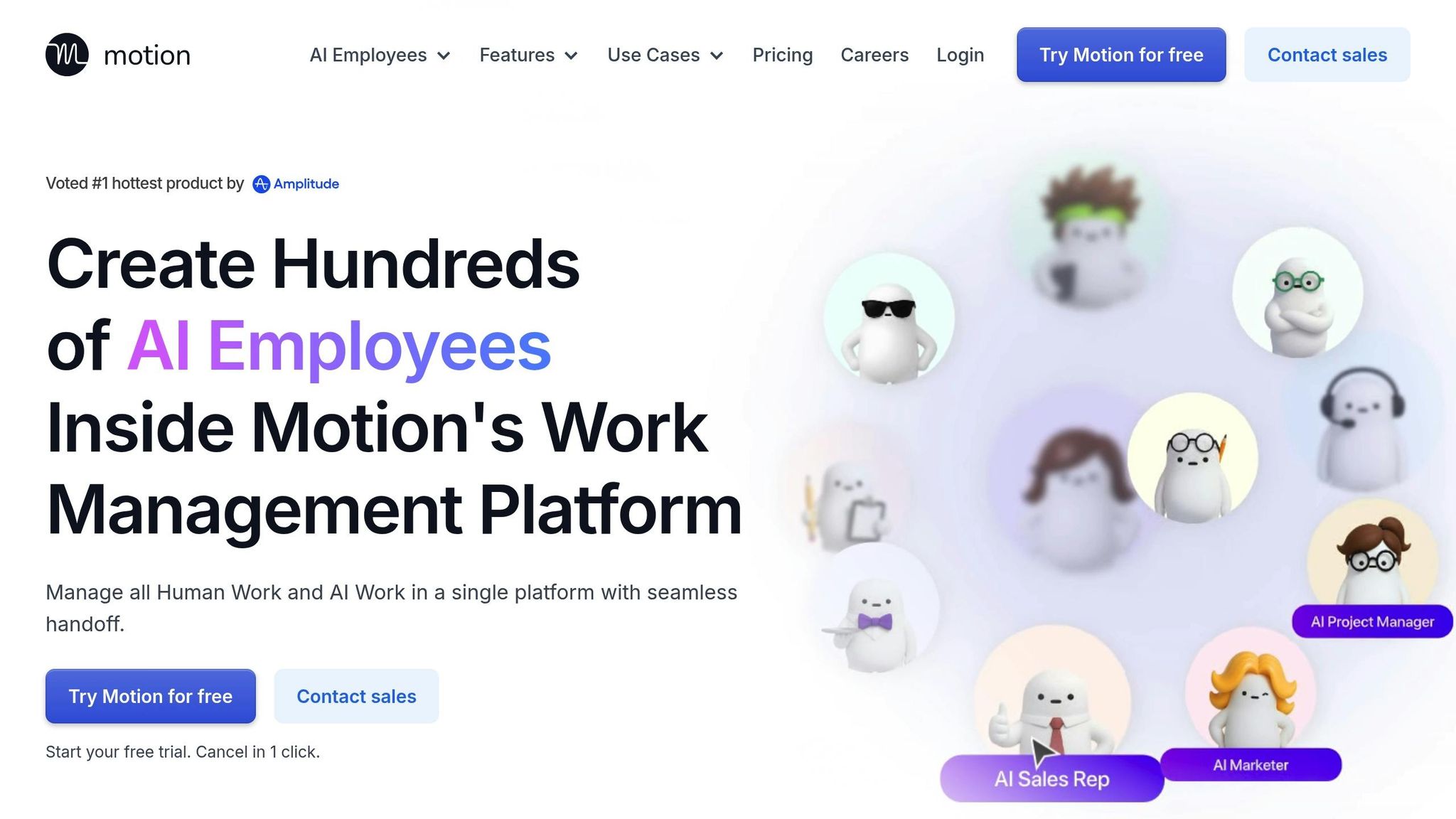
Motion takes the hassle out of managing your schedule by using AI to organize tasks and calendars automatically. Unlike basic calendar apps, it prioritizes tasks, adapts to changes in real-time, and learns your work habits to create a schedule that fits your workflow. By aligning your tasks with your actual work patterns, Motion helps you stay productive and on track.
Core Features
At the center of Motion is its AI Scheduler, which automatically assigns time blocks for tasks based on priority, deadlines, and availability. For example, if you add "Prepare quarterly report" to your task list, Motion will carve out focused work sessions in your calendar. It even adjusts dynamically when new meetings or urgent tasks come up, so you don’t have to.
The Project Management feature simplifies handling complex projects by breaking them into smaller, actionable tasks. It tracks deadlines automatically and allocates time for each part of the project. If an unexpected delay occurs, like a meeting running long, the AI will reschedule tasks to keep your project on track.
Focus Time Protection is another standout feature. It identifies your most productive hours and safeguards them by declining non-essential meetings or suggesting alternative times. Motion also integrates with popular tools like Slack, Google Workspace, and Microsoft 365, ensuring all your workflows are consolidated in one place.
For teams, Motion offers Team Coordination tools to help managers distribute workloads effectively. The AI assigns tasks based on each team member’s capacity and skills, preventing burnout while maintaining progress. With real-time visibility into everyone’s schedule, managers can spot potential bottlenecks and address them before they cause delays.
These features make Motion a versatile tool for various industries.
Use Cases
Motion caters to professionals who need help managing complex schedules:
- Consultants and freelancers use Motion to handle multiple client projects without overbooking or missing deadlines. The AI allocates time based on contract needs and project milestones.
- Marketing teams rely on it to organize campaign launches, content schedules, and meetings. It ensures creative work gets uninterrupted focus time while keeping team coordination smooth.
- Software developers use Motion to plan coding sprints, reviews, and testing phases. When bugs or requirement changes arise, the AI adjusts schedules accordingly.
- Executive assistants manage intricate calendars for executives, finding the best meeting times across time zones while preserving time for strategic thinking.
- Sales professionals balance prospecting, client calls, and admin tasks, ensuring steady progress on pipelines without neglecting client relationships.
Pricing in USD
Motion keeps its pricing simple:
- Individual Plan: $34.00 per month when billed annually, or $39.00 monthly. Includes unlimited tasks, projects, and AI scheduling for one user.
- Team Plan: $20.00 per user per month when billed annually, or $25.00 per user monthly. Includes shared projects, workload balancing, and collaborative scheduling.
Both plans come with unlimited calendar integrations, mobile apps for iOS and Android, and 24/7 customer support. A 7-day free trial is available, and no credit card is required to test out the platform.
Limitations
Motion performs best when users have consistent routines and preferences. It takes some time for the AI to learn your habits, so the initial scheduling suggestions might not be spot-on in the first few weeks.
The platform also requires detailed task entries to function effectively. Vague inputs like "work on project" won’t provide enough context for the AI to schedule intelligently. Users need to include time estimates and priority levels for optimal results.
While Motion integrates with major tools like Slack or Google Workspace, it might not sync seamlessly with niche industry software, which could require manual updates. Additionally, the structured scheduling approach may feel restrictive for creative professionals who prefer more flexible, inspiration-driven workflows.
6. Zapier - Best for Automation Workflows
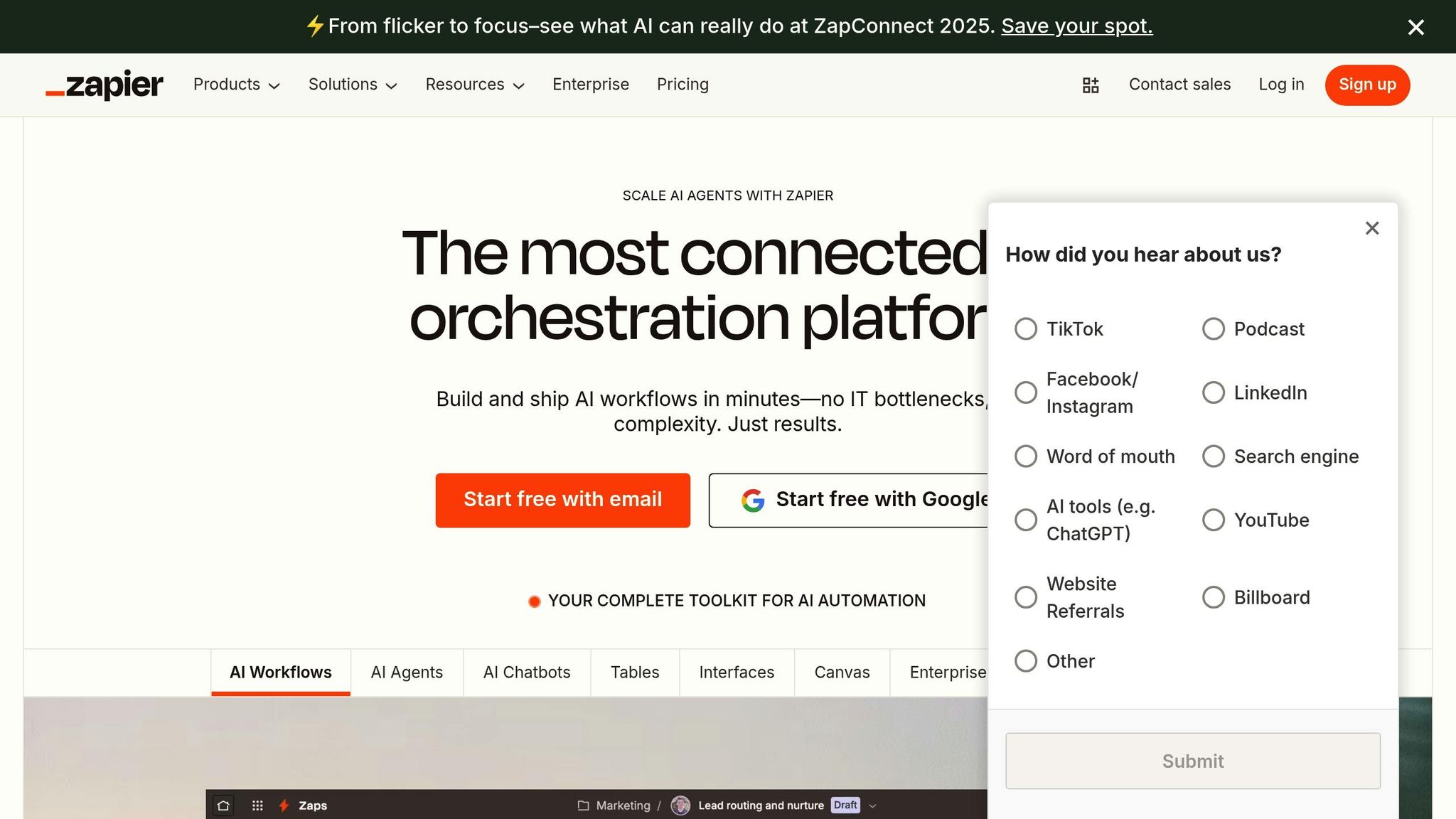
Zapier connects your go-to apps to handle repetitive tasks automatically. Instead of spending time manually transferring data or performing the same actions over and over, Zapier creates automated workflows - called "Zaps" - to take care of these processes in the background.
Core Features
At the core of Zapier is its Zap Builder, which allows you to create automation workflows between over 6,000 apps. Here's how it works: a trigger in one app kicks off actions in others. For instance, if someone fills out a lead form on your website, Zapier can instantly add them to your CRM, send a welcome email, and create a follow-up task - all without you lifting a finger.
With Multi-Step Zaps, you can link several actions together. For example, when a customer makes a purchase, Zapier can send a receipt, add the buyer to your email list, generate a shipping label, and notify your logistics team.
Filters and Paths let you fine-tune workflows by setting conditions. For example, you can configure it to only create tasks if a deal's value exceeds $1,000.
Zapier also supports Team Collaboration, allowing shared access, permission settings, and workflow monitoring to ensure everything runs smoothly across your team.
Use Cases
Zapier is a game-changer for professionals who want to cut down on manual work across various industries:
- E-commerce businesses: Automate order processing by linking Shopify to inventory systems, email marketing tools, and accounting software. When an order comes in, tasks like updating stock, sending confirmation emails, and logging sales happen automatically.
- Marketing agencies: Simplify lead management by connecting forms to CRMs, triggering personalized email campaigns, and assigning tasks to sales teams. Social media posts can be tracked in Google Sheets for easy client reporting.
- Real estate agents: Streamline property listings by syncing MLS systems with social media, email campaigns, and client databases. New listings can automatically generate marketing materials and notify potential buyers.
- HR departments: Speed up employee onboarding by linking applicant tracking systems to payroll, IT tools, and training platforms. Tasks like setting up accounts and sending welcome emails are handled seamlessly.
- Content creators: Automate publishing workflows by tying content management systems to social media, email newsletters, and analytics. A single blog post can trigger social media updates, email campaigns, and performance tracking.
Pricing in USD
Zapier offers flexible pricing plans to suit different business needs:
- Free Plan: $0.00/month – Includes 100 tasks monthly and up to 5 single-step Zaps.
- Starter Plan: $29.99/month – Offers 750 tasks monthly, multi-step Zaps, and premium app integrations.
- Professional Plan: $73.50/month – Includes 2,000 tasks monthly, unlimited premium apps, custom logic, and paths.
- Team Plan: $103.50/month – Provides 2,000 tasks monthly plus team collaboration tools and shared workspaces.
- Company Plan: $415.00/month – Features 50,000 tasks monthly, advanced admin controls, and priority support.
All paid plans include unlimited Zaps, email support, and access to Zapier's extensive app directory. Tasks are counted each time a Zap runs, so multi-step Zaps will use multiple tasks.
Limitations
While Zapier excels at automation, it works best with apps that have strong APIs and frequent data updates. Some platforms have limited integration options, which can restrict the workflows you can build. In addition, real-time syncing isn’t always available, and depending on your plan, Zaps may experience delays of 1–15 minutes.
Creating overly complex workflows can also lead to challenges. If multiple Zaps interact with the same data, it may cause conflicts or duplicate actions. Setting up proper filters and conditions is crucial to avoid unnecessary triggers.
For businesses with high automation needs, task limits can become an issue. A single workflow with multiple steps can quickly eat into your monthly task allowance. Premium app integrations are also locked behind higher-tier plans, which could increase costs for businesses relying on specialized tools.
Finally, Zapier lacks advanced error handling and debugging tools. If a Zap fails, troubleshooting can be tricky, especially in multi-step workflows. This makes it less ideal for businesses that need highly customized or fail-safe automation solutions.
7. Perplexity AI - Best for Research and Answer Engines
Perplexity AI makes research easier by providing clear, source-backed answers in a conversational style. This tool is designed to simplify information gathering, offering direct responses in a way that feels like a natural dialogue. Its emphasis on conversational interaction complements other tools in this guide that focus on boosting productivity and creativity.
Core Features
- Conversational Interface: Ask questions in plain language and get responses that build on previous queries.
- Source Citations: Each answer includes references to original sources, so you can verify details or dive deeper into specific topics.
- Organized Research Sessions: Supports follow-up questions, enabling a smooth and coherent research flow.
Use Cases
Perplexity AI is a valuable resource for anyone looking for clear, verified insights to support various activities:
- Academic Research: Quickly grasp complex topics and access cited references for further study.
- Business Intelligence: Summarize industry trends and market data to guide strategic decisions.
- Content Creation: Collect reliable information to support writing or marketing projects.
- Technical Problem-Solving: Find dependable solutions for troubleshooting or learning about new technologies.
- Personal Learning: Explore topics or current events in an engaging and interactive way.
Limitations
Although Perplexity AI excels at synthesizing information, users should cross-check details with the original sources. It may occasionally miss subtle nuances or struggle with rapidly evolving topics. The tool is best suited for fact-based queries, so for highly detailed or subjective issues, additional verification is recommended.
sbb-itb-212c9ea
8. Canva AI - Best for AI Design Assistance
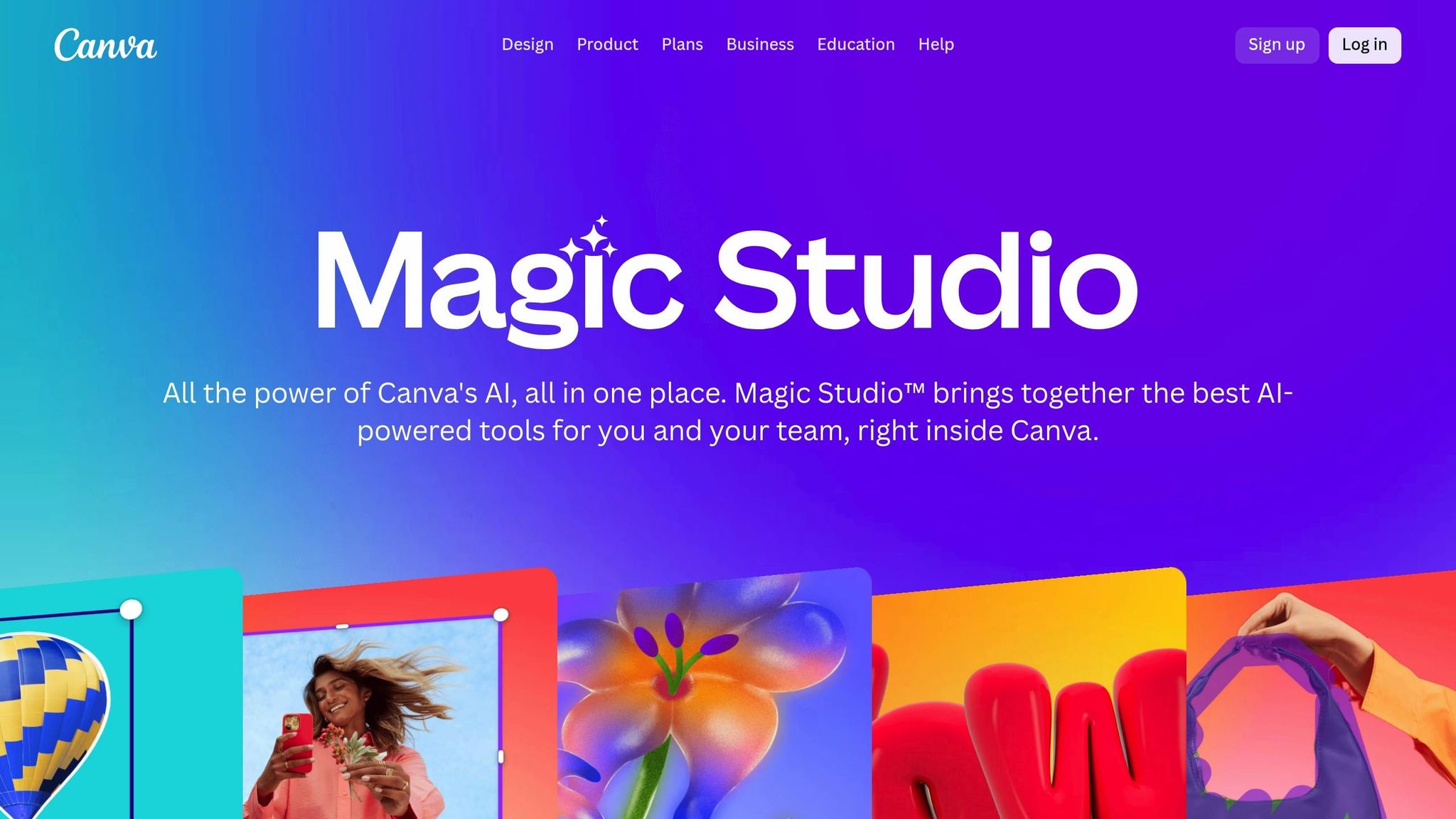
Canva AI simplifies the process of creating high-quality graphics by combining user-friendly tools with artificial intelligence. Its Magic Studio suite integrates AI features directly into the design process, making it easier to generate images, write copy, and refine visuals - all in one seamless workflow. Here's a closer look at what Magic Studio offers.
Core Features
Magic Studio brings a range of tools to the table, including:
- Magic Write, which generates copy effortlessly.
- Text-to-Image, allowing users to create custom visuals from written prompts.
- Background Remover, which isolates image subjects in seconds.
- Magic Resize, which adjusts designs to fit various platforms and formats automatically.
In addition to these tools, Canva AI includes a Brand Kit to ensure consistent use of logos, colors, and fonts. Teams can collaborate in real time, with version control and commenting features simplifying group projects. The Visual Suite offers access to over 100 million premium stock photos, videos, and graphics, all enhanced by AI-driven tools.
Use Cases
Canva AI is versatile enough to meet the needs of a wide audience, from small businesses to large enterprises:
- Small businesses can create professional marketing materials without hiring a designer.
- Marketing teams can generate campaign copy and branded visuals quickly and at scale.
- Educators can design engaging lesson plans and infographics.
- Content creators can produce eye-catching YouTube thumbnails and Instagram posts.
- Nonprofits can craft polished fundraising materials using professional design tools.
- Enterprise teams can maintain consistent branding across large organizations.
This blend of AI-powered tools and user-friendly design makes Canva AI a go-to platform for diverse projects, complementing the productivity tools we've discussed earlier.
Pricing in USD
Canva AI offers flexible pricing plans to suit a variety of users:
| Plan | Monthly Price | Annual Price | Minimum Users | AI Credits (Monthly) | Storage |
|---|---|---|---|---|---|
| Free | $0 | $0 | 1 | Limited (50 total uses) | 5 GB |
| Pro | $15 | $120 ($10/month) | 1 | 500 each for Magic Write & image generation | 1 TB |
| Teams | $10 per person | $100 per person | 3 | 500 each per person | 1 TB/user |
| Enterprise | Custom pricing | Custom pricing | 100+ | Unlimited | 1 TB/user |
The Pro plan offers savings with annual billing, reducing the cost from $180 to $120 per year. The Teams plan, starting at $30 per month for three users, is ideal for small groups. Canva also provides free Pro-level plans for Education and Nonprofit organizations, with nonprofits eligible for up to 50 users.
"It's the first all-in-one AI design platform on the market. The real power of Canva comes from being able to have it all integrated into workflows."
This insight from Melanie Perkins, Canva's Co-founder and CEO, highlights the platform's integrated approach.
Limitations
Despite its strengths, Canva AI has some constraints:
- AI usage caps: Free users are limited to 50 total uses of Magic Write and image generation, while paid plans offer 500 monthly credits for each feature. Unfortunately, there's no option to purchase additional credits - you'll need to wait for the monthly reset.
- Storage limits: The free plan includes only 5 GB of storage, which may not be enough for heavy users.
- Team plan costs: The minimum requirement of three users can make the Teams plan less affordable for smaller groups.
- Premium asset fees: Free plan users must pay $1 per premium element used in their designs.
While the monthly pricing may seem steep, the annual plans provide better value. As Jonathan Goldberg, CEO of Kimberfire, puts it:
"While it's certainly something that impacts our budget, the value Canva provides, especially with its AI features, has made it worthwhile so far."
These trade-offs are typical for platforms that incorporate AI, balancing advanced features with practical limitations.
9. Rev AI - Best for Transcription and Meeting Intelligence

Rev AI is a tool designed to turn audio and video into text while pulling out key insights from conversations. It's not just about transcription - it also helps organize multi-speaker discussions and pinpoints important moments.
Core Features
Rev AI’s transcription engine is built for accuracy, handling a variety of languages and accents, making it a reliable option for scenarios like board meetings or customer calls. Its real-time transcription works seamlessly for live events or ongoing meetings.
The platform includes speaker identification, distinguishing voices and labeling each speaker throughout the transcript. It also offers custom vocabulary training, which enhances recognition of industry-specific terms, company names, and technical jargon.
Beyond transcription, Rev AI provides tools to identify action items, key decisions, and important discussion points. Features like sentiment analysis and keyword spotting add depth to its review capabilities. It integrates easily with popular platforms like Zoom, Microsoft Teams, and Google Meet, and its API allows embedding directly into workflows.
Use Cases
Rev AI’s features make it versatile across professional fields:
- Legal: Clear transcriptions of depositions, client meetings, and court proceedings ensure reliable records.
- Healthcare: Detailed transcripts of consultations and conferences help streamline documentation.
- Sales: Teams use transcribed conversations to track discussions and follow up on action items.
- Research and Academia: Speaker identification aids in attributing quotes during interviews and lectures.
- Media: Transcripts for podcasts, videos, and interviews simplify content creation.
Pricing
Rev AI uses a pay-as-you-go pricing model with several service options. It offers both asynchronous and streaming APIs for efficient machine transcription, along with a human transcription service for those needing extra precision. New users may benefit from a limited amount of free transcription each month, and discounts or enterprise plans are available for larger-scale needs. For the most accurate pricing details, it’s best to check Rev AI’s official website.
Limitations
While Rev AI is robust, there are a few drawbacks to consider. Costs can add up with high transcription volumes. Accuracy might fluctuate depending on audio quality, heavy accents, or overlapping speakers. Customization options for specific output formats are somewhat limited. Organizations with strict data retention or compliance requirements should review Rev AI’s storage policies, as audio files and transcripts are kept on its servers. Additionally, mastering the platform’s advanced features may require some time and effort for teams unfamiliar with analytics tools.
10. DALL-E 3 - Best for Image Generation
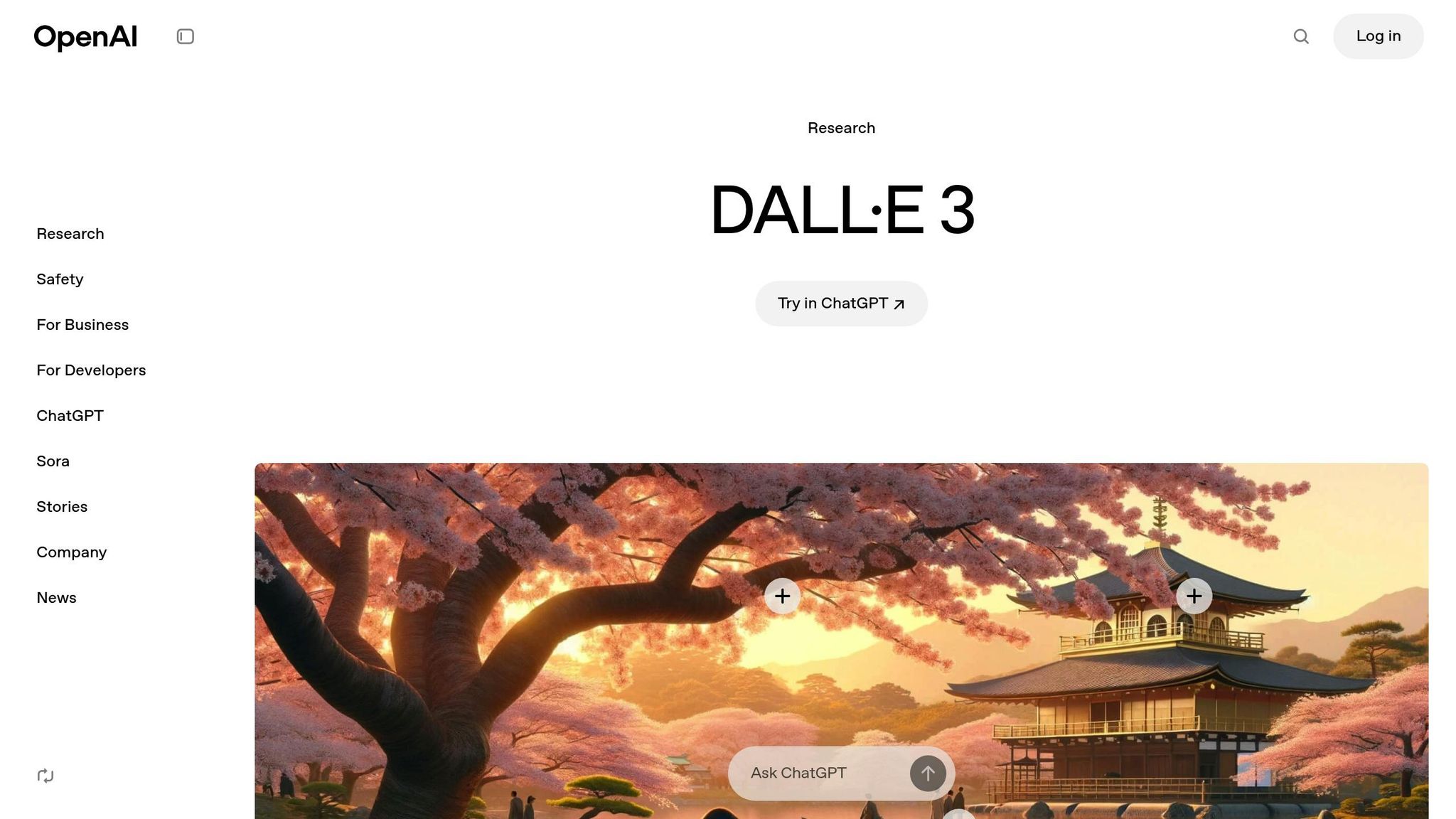
DALL-E 3 transforms text prompts into stunning visuals, making it a go-to tool for creative professionals.
Core Features
DALL-E 3 delivers visuals in both standard and HD resolutions, supporting popular aspect ratios like square (1024×1024) and rectangular (1024×1792 or 1792×1024). Users can add flair to their creations with style options such as vivid for artistic effects or natural for photorealistic results.
Use Cases
DALL-E 3 is a versatile tool for professionals across various creative fields:
- Marketing teams: Design custom visuals for campaigns without relying on stock photos.
- Content creators: Craft unique thumbnails and graphics for social media platforms.
- Small businesses: Develop branded imagery for websites and promotional materials.
- Educators: Create engaging visual aids and illustrations for lesson plans.
- Publishers: Design book covers and editorial illustrations with ease.
Pricing
You can access DALL-E 3 through subscription plans or a pay-as-you-go model:
- ChatGPT Plus: $20 per month.
- ChatGPT Pro: $200 per month.
- ChatGPT Team: Starts at $25 per user per month (billed annually) or $30 per user per month for monthly billing.
For higher-volume needs, the OpenAI API charges $0.04 per standard 1024×1024 image and $0.08 per HD image. Alternatively, the Azure OpenAI Service offers pricing at $4 for 100 standard images and $8 for 100 HD images.
Limitations
While ChatGPT subscriptions offer convenient access, they come with rate limits, making the API model a better choice for users with high-volume demands. All images created with DALL-E 3 are cleared for commercial use, making it a powerful yet usage-sensitive option for creative professionals.
11. Gamma - Best for Presentation Creation
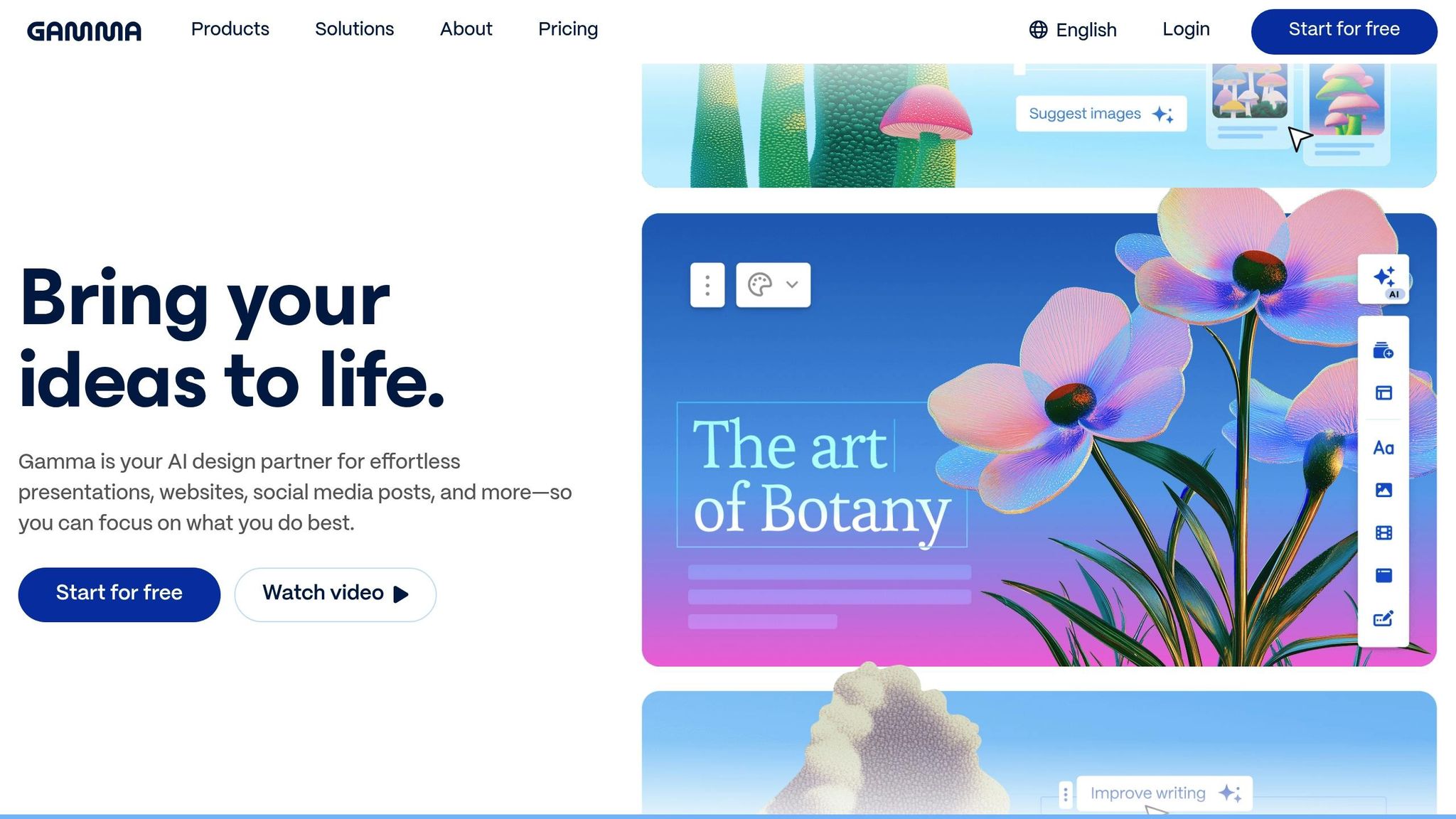
Gamma simplifies presentation creation by using AI to transform text prompts into fully formatted, professional slides. This tool takes the hassle out of designing presentations, saving hours of manual effort.
Core Features
Gamma’s AI-driven platform can craft complete presentations from simple outlines or prompts, automatically selecting layouts, colors, and visuals. On its highest subscription tier, users can create presentations with up to 60 cards and even publish them as websites.
The platform also offers advanced features like premium AI image generation through models such as DALL-E 3 (available for Pro users). Additional customization options include custom fonts, detailed analytics, and password protection for sensitive content. Users can also share their work with branded links by utilizing custom domains and URLs. These features make it easy to produce visually appealing presentations with minimal input.
Use Cases
Gamma is ideal for professionals who need quick, high-quality presentation solutions across various industries:
- Marketing Teams: Create polished pitch decks and campaign presentations from brief outlines.
- Consultants: Turn client research into compelling visual narratives.
- Educators: Build engaging lesson materials with ease.
- Sales Professionals: Quickly tailor presentations for different prospects.
- Startup Founders: Design investor pitch decks that maintain consistent branding and a professional aesthetic.
Pricing
Gamma offers three pricing tiers to suit different needs:
- Free Plan: Includes 400 one-time AI credits, basic image generation, and up to 10 cards per presentation. All creations display "Made with Gamma" branding.
- Plus Plan: Costs $10 per user per month (or $8 per month with annual billing). This plan removes Gamma branding, allows unlimited AI creations, supports up to 20 cards per presentation, and includes 100,000 AI token inputs.
- Pro Plan: Priced at $20 per user per month (or $15 per month with annual billing), this tier includes everything in the Plus Plan, along with premium AI image generation, advanced AI editing, up to 60 cards per presentation, Beta API access, custom fonts, detailed analytics, and enhanced sharing features like custom domains and password protection.
Limitations
The Free Plan’s 400 credits are a one-time allocation and do not renew, making it less suitable for users with ongoing needs. AI actions consume credits at varying rates - for example, generating a full deck uses 40 credits, while adding a single card requires 5 credits. Additionally, Free Plan users lack access to collaboration features like real-time editing, commenting, and notifications. For teams or individuals with high-volume presentation requirements, upgrading to one of the unlimited paid plans may be more practical and cost-efficient.
Pros and Cons Comparison
Based on our in-depth reviews, here’s a breakdown of the strengths and weaknesses of various AI tools, helping you decide which ones align best with your needs, budget, and workflow.
AI discovery platforms like AI Apps excel in offering a vast directory of over 1,000 curated tools with advanced filtering options. However, they don’t perform any AI functions themselves, serving more as a resource hub.
Meeting and transcription tools such as Otter.ai and Rev AI deliver real-time, accurate transcriptions. Yet, their free plans often restrict the number of transcription minutes, which means frequent users might need to upgrade for extended functionality.
Workspace and productivity apps like Notion AI and Motion integrate smoothly into existing workflows. Notion AI is particularly effective for creating content within knowledge bases, while Motion’s AI scheduling can save hours in managing calendars. That said, both tools require some time to master before they can be used efficiently.
Creative AI tools come with their own benefits and challenges. For example, DALL-E 3 creates stunning images but operates on a credit system, which can become costly with heavy usage. Runway ML offers advanced video generation capabilities but may pose challenges for beginners due to longer rendering times and a steeper learning curve. Canva AI, on the other hand, provides user-friendly design assistance, though experienced users might find its templates somewhat restrictive. Here’s a quick summary of these tools:
| App Category | Strengths | Weaknesses | Best For |
|---|---|---|---|
| Discovery Platforms | Comprehensive databases, filtering options | No direct AI functionality | Finding specialized AI tools |
| Meeting Tools | High accuracy, real-time processing | Limited free minutes, subscription costs | Regular meeting attendees |
| Productivity Apps | Workflow integration, time-saving automation | Learning curves, added complexity | Teams and power users |
| Creative Tools | High-quality outputs, diverse formats | Credit systems, rendering delays | Content creators and designers |
| Automation Platforms | Extensive integrations, workflow flexibility | Setup complexity, varying pricing tiers | Business process optimization |
Beyond these categories, automation, presentation, and research tools also bring unique trade-offs. Automation tools like Zapier connect thousands of apps, making workflows more efficient. However, setting up intricate workflows can be time-consuming. Research tools such as Perplexity AI are great for robust research but may struggle with highly specialized or niche queries.
Presentation tools like Gamma simplify traditionally time-intensive tasks, creating entire presentations from simple prompts. While this saves significant time, limited free credits can restrict frequent use, and premium features like custom domains or analytics often come with higher costs.
Pricing varies widely across these tools. Free tiers might suffice for occasional users, but advanced features typically require subscriptions or credit systems, which can complicate budgeting for regular or heavy users.
Integration capabilities also play a key role in determining a tool’s value. Tools with strong API support and third-party app connections often cater better to businesses, while standalone apps may better suit individual users. For example, Canva AI provides immediate benefits with little to no training, whereas tools like Notion AI or Runway ML demand more time but reward users with advanced functionality. Matching a tool’s complexity to your team’s technical comfort and training resources is critical for success.
Conclusion
The AI landscape as of August 2025 offers an impressive array of tools tailored to meet diverse professional needs, from streamlining workflows to generating content. For users in the US, key considerations include affordability, integration capabilities, ease of use, and pricing structures.
For businesses focused on affordability, free tiers serve as an excellent starting point, while subscription plans provide access to more advanced features for those looking to expand their capabilities.
Beyond just cost, integration plays a crucial role in selecting the right tools. Platforms like Zapier and Notion AI demonstrate how seamless connectivity can simplify workflows, reducing the hassle of juggling multiple applications.
Ease of use and technical readiness are also critical factors. Tools like Canva AI are designed for quick adoption, requiring minimal training to deliver results. On the other hand, platforms like Runway ML may demand a steeper learning curve but offer more advanced features for those willing to invest the time. Businesses need to evaluate their teams' technical skills before choosing tools that may require additional training.
Flexible pricing models cater to various user needs. Tools offering free tiers or credit-based systems work well for occasional users, while subscription plans provide predictable costs for those requiring regular access.
For navigating this vast landscape, AI Apps stands out as a valuable resource. With a curated directory of over 1,000 AI tools and advanced filtering options, it helps US users quickly identify solutions tailored to their specific needs.
To make the most of these tools, align their features with your immediate business priorities. Whether you're looking to improve meeting management, streamline scheduling, or enhance research processes, focus on adopting the solution that directly addresses your most pressing challenge. Avoid spreading resources thin by implementing multiple tools at once.
Start small, test thoroughly, and expand as you begin to see measurable results. This approach ensures you can tackle challenges effectively and turn them into opportunities for growth.
FAQs
How can I choose the right AI app for my business needs?
Choosing the Right AI App for Your Business
Finding the best AI app for your business starts with understanding your specific goals and challenges. Pinpoint what you want to achieve and the hurdles you face. Then, focus on tools that offer features tailored to those needs and have a strong track record in your industry. Checking user reviews and case studies can give you a clearer picture of how well an app performs and how reliable it is.
It's also important to ensure the app works seamlessly with your current systems and has the ability to grow alongside your business. Take a close look at your data readiness - this helps determine whether the AI tool can provide accurate, actionable insights. By keeping these factors in mind, you’ll be better equipped to choose an AI solution that aligns with your business goals.
What should I look for in an AI app when it comes to integration and ease of use?
When picking an AI app, prioritize its ability to integrate smoothly with your current systems and its simplicity to use. Check if it works well with your existing tools, supports APIs for easy connections, and aligns with your specific workflows. A clean, intuitive interface and a hassle-free onboarding process can make a big difference in how quickly your team adapts to the new tool.
To ensure success, start by defining your objectives and assessing whether your data is ready for integration. Testing the app with a small pilot project is a smart way to gauge its usability and effectiveness before committing to a full rollout. By considering these factors, you’ll be better equipped to select an AI app that truly meets your requirements.
What are the best ways to manage costs when using AI apps with credit-based or subscription pricing models?
To keep your costs under control when using AI apps with credit-based or subscription pricing models, start by analyzing how you typically use these tools. Look for a plan that aligns with your actual needs. Many apps offer tiered pricing or usage-based plans, so you can avoid paying for features you don’t need.
It’s also a good idea to monitor your app usage regularly. This helps you spot patterns and make adjustments to your plan if necessary. Some apps offer pre-paid credit systems or hybrid models that combine a basic subscription with pay-as-you-go options - these can give you more predictable costs and better control over your spending. Setting up usage limits or alerts is another smart way to avoid surprise charges.
By staying on top of your usage and regularly evaluating your plan, you can manage your budget effectively while still getting the most out of your AI tools.



